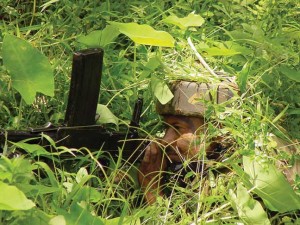Mr Hiteshwar Saikia told me: “These ULFA boys do not understand that they can not achieve their aim. They can only create hardships for the people of Assam. Where will they get such a large quantity of arms and ammunition from to fight the Army? And how will they bring it into Assam? With such geographical handicaps, will they be ever able to face the might of the Army? They are mistaken if they think they can carve out Vietnam-type or Afghanistan-type victories. The case there was different. Assam is neither Afghanistan nor Vietnam, and Indian Army is not an occupation army.”
Assam, had a population figure of 3.1 million. Applying an all India population growth factor of 13 percent annual increase, its population in 2001 should have been 12.43 million and not 26.6 million as the census of 2001 reveals. Out of this, the Muslim population today is 30.9 percent which was barely 8-9 percent in 1950.
India has been a victim of WOM (war by Other Means) launched by our western neighbour since 1989, but we have failed to read the writings on the wall. The attack on Mumbai through the sea on 26 November 2008 has further demonstrated the sophistication of the architects and soldiers of WOM. A handful of well-trained and regimented ‘irregular soldiers’ of WOM brought Mumbai to standstill, nay the whole of India. The WOM does not need regular soldiers ‘monkey dancing’ across the opposing borders. The old concept of war has now been made redundant due to ‘nuclearisation’ of South Asia and rapid globalization. The WOM is fought by ‘irregular soldiers’ called militants/terrorists; ‘Smart Soldiers’, called ‘Spin Doctors’ and ‘Cyber Soldiers’ called the ‘Techies’. WOM has no ‘front’, no ‘rear’. The whole of India is a battlefield.
Inherent weaknesses and vulnerabilities of the Indian Nation in the form of religious, regional, lingual, economic and social cleavages, along its length and breadth, present themselves for exploitation by the architects of WOM against India. Our poor national leadership and wrong national policies, since independence, have allowed these inherent ‘pin holes’ in our ’structural unity’ to become wide gaps for our enemies to sneak in. From Assam to J&K and Mumbai to Singur the story has a universal script. Add to it, Jaipur, New Delhi, Ahemdabad, Bangalore, Kanpur, Lucknow, Hyderabad and the entire Northeast; you have a very gloomy picture of India. These weaknesses and vulnerabilities act as localized ‘niches’ of conflict. I would like to call them as the ‘designer conflicts’. Our isolated approach of treating it as law & order problems or communal violence or even as militancy, allows them to keep simmering. Thus, the ISI of Pakistan continues to torment India from Mumbai to Kashmir and Assam to Bangalore with regular periodicity. To deal with WOM and ‘designer conflicts’, we need an integrated approach at the national level – not merely a so called NIA (National Investigating Agency).
 Assam is a victim of such ‘niche war’ unleashed by ULFA but supported by the ISI of Pakistan. Nine serial blasts in Assam on 30th October 2008 have highlighted the fact that militancy and insurgency in Assam has not only upgraded itself but has also acquired operational sophistication and great degree of inter-organization coordination. The situation is now becoming worse than the period when militancy started some three decades back. ULFA militants have become more aggressive and violent. It also speaks of their foreign nexus and the arsenal at their command including the expertise to carry out such serial blasts.
Assam is a victim of such ‘niche war’ unleashed by ULFA but supported by the ISI of Pakistan. Nine serial blasts in Assam on 30th October 2008 have highlighted the fact that militancy and insurgency in Assam has not only upgraded itself but has also acquired operational sophistication and great degree of inter-organization coordination. The situation is now becoming worse than the period when militancy started some three decades back. ULFA militants have become more aggressive and violent. It also speaks of their foreign nexus and the arsenal at their command including the expertise to carry out such serial blasts.
It is claimed that these blasts are a closely coordinated act of ULFA, HUJI and NDFB. If this nexus exists, then ULFA militancy has come to stay in Assam. We could have avoided all this.
ULFA insurgency in Assam, through the decades of eighties and nineties, did not spring up suddenly and overnight. It graduated from ‘honeymoon dream’ of a few frustrated youths into a fire-ogling monster. Like an expanding torrent, it devoured the public mind; it nibbled at the efficacy of the state administration; it undermined and neutralized the state police, and its writ began to run all over Assam. Kidnappings at will; extortions in broad-day light and summary executions of people under the very nose of state administrative machinery, left no doubt in the minds of the people as to who the real masters were. ULFA had become a house-hold name in Assam by the end of eighties.
As it ever happens, when everything failed, the Army was called upon to clear up the mess created by ULFA. Thus, in November, 90, began the story of the twists and turns in the Army operations which were first conducted in two phases under code names ‘Operation Bajrang’ and ‘Operation Rhino’ from November 1990 to May 1992. Then followed a period of four years calm and tranquility when ULFA disappeared from the scene and an illusion of peace was created. But peace remains a distant dream for Assam and as such India.
The bubble of peace burst in June 1996 when ULFA again raised its inexorable head which continues to do so even in the year 2009, some 13 years later. To understand the sustainability of ULFA militancy we ought to understand the genesis of the ASSAM problem.
Shrinking Land Mass: Bloating Population
If we consider the census figures of 1901, then it would be realized that the landmass that currently constitutes Assam, had a population figure of 3.1 million. Applying an all India population growth factor of 13 percent annual increase, its population in 2001 should have been 12.43 million and not 26.6 million as the census of 2001 reveals. Out of this, the Muslim population today is 30.9 percent which was barely 8-9 percent in 1950. This abnormal increase is primarily due to influx of outsiders, which has affected the demography of Assam.
It is to the credit of its sharp intelligence and visionary intellect that ULFA leadership has been able to save itself twice from a total collapse under the weight of two well launched Army Operations, i.e. “˜Operation Bajrang and “˜Operation Rhino. Each time it salvaged itself with great cunning and shrewd strategy.
Compare this with the corresponding decrease in the landmass. In 1912, when chief commissioner-ship of Assam was established by annulling the partition of Bengal (affected in 1905) the total area of Assam was approximately 2, 24,600 square kilometers. Ever since independence, the land mass has been shrinking and today it stands at approximately 78,000 square kilometers which is just one-third of its pre-partition size.
Thus, the shrinking landmass and an increasing influx of outsiders created unique demographic bulges which threatened to submerge the indigenous population of Assam. Obviously, this was bound to create tension and give rise to a movement, which sought to remove these imbalances. As a result, in 1979, a student’s agitation, spearheaded by all Assam Student Union, (AASU), was launched to voice the concern against the increasing influx of foreigners in Assam. This foreigner’s issue engendered the growth of militancy in Assam.
The influx of foreigners into Assam was in two phases, i.e. pre-independence phase and the post-independence phase. The pre-independence influx started in 1826 with the beginning of British rule in Assam. This phase can be further divided into two periods, i.e. 1826 to1905 and 1905 to 1947. In the first period the influx of outsiders pertained to three classes of people – tea plantation laboruers from Bihar and Orissa; office employees from Bengal who came with the British administration and tradesmen from Rajasthan and Bengal. Then in 1905 Bengal was partitioned and a separate province of East Bengal and Assam was established. This triggered the influx of Muslim peasants from East Bengal into Assam who began settling in the rural areas of Assam.
Though the partition of Bengal was annulled in 1912, the trend carried on till 1947. Also, during this period, Bengali Hindus poured into Assamese towns. Thus by 1947 there were three million non-indigenous people in a total population of about seven million, which amounts to 43.8 percent.
The second phase of influx began in 1947. A large number of Bengali Hindus migrated to Assam during partition. Even after the partition the influx continued, and by 1963, millions of people from East Bengal and Nepal had settled in Assam. It got checked for a short period but restarted in 1970. While the influx of outsiders continued, the state of Assam was fragmented. In 1963 Nagaland was carved out, and in 1972 Mizoram and Meghalaya were established as seperate entities. There was general resentment against such political divisions.
Shrinking landmass and continuous influx of outsiders affected social and political life in Assam. The indigenous people of Assam felt that they may be reduced to a minority and thus lose their say in the governance of Assam. The changing demographic pattern even threatened the cultural and ethnic identities of the tribal people. This created general frustration and disenchantment against the authorities, particularly the central government.





Hahahah such an idiotic post where was central govt after 1971 when bl@@@y Bangladeshis invaded Assam, Where was Army when china invaded north east as@@@@le ra@@y you came to save your people not indigenous people of north east ra@@y f@@k@@s